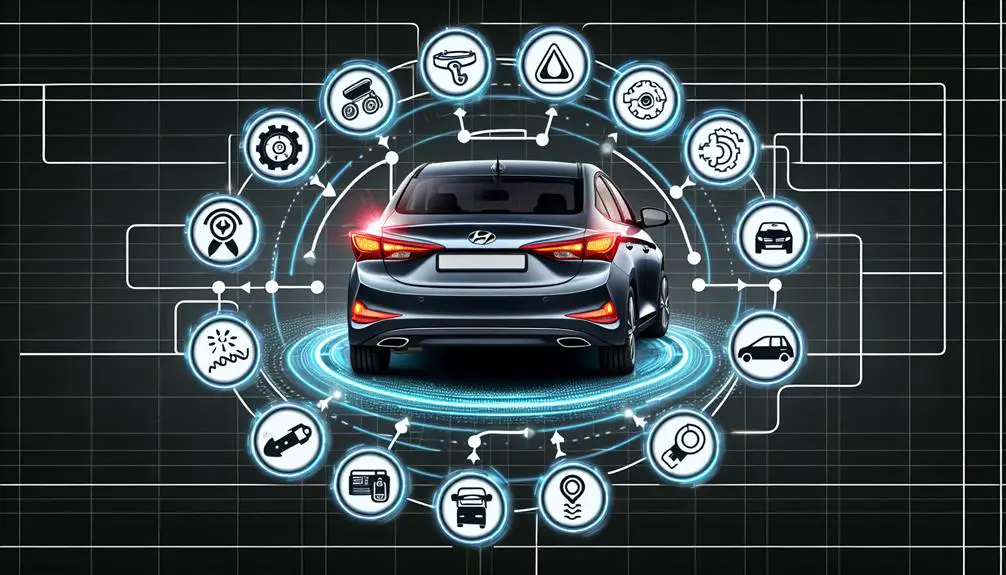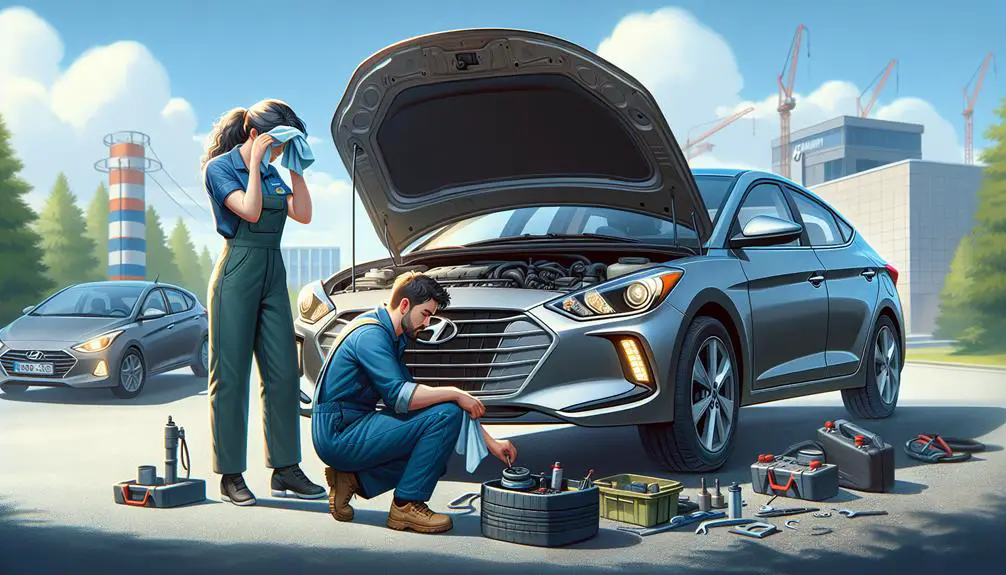If your Hyundai Elantra brake light stays on, it can indicate a problem with the brake system. The most common reasons for this issue are low brake fluid level, a faulty brake light switch, or a problem with the brake pads or rotors.
To address this problem, start by checking the brake fluid level in the reservoir and topping it up if it's low. If the fluid level is normal, you may need to inspect the brake light switch located near the brake pedal. It's also a good idea to visually inspect the brake pads and rotors for any signs of wear or damage.
If you're unable to identify the cause of the issue or if the brake light continues to stay on after addressing these potential causes, it's recommended to have your vehicle inspected by a professional mechanic to diagnose and resolve the problem effectively.
Common Causes Explained

Understanding the common causes of Hyundai Elantra brake light issues can save you time and frustration. Often, these problems are rooted in simple malfunctions or wear and tear that you can easily address. Let's delve into what might be going on with your vehicle.
One of the most straightforward reasons your brake light stays on is a misaligned or faulty brake light switch. This switch, located near the brake pedal, activates your brake lights when you press down on the pedal. If it's not properly aligned or has failed, your brake lights mightn't turn off. You'll need to adjust or replace the switch to solve this issue.
Another common culprit could be a blown fuse. Your car's fuse box houses the brake light circuit fuse. If this fuse blows, your brake lights might remain illuminated or not work at all. Checking and replacing a blown fuse is a quick fix that you can do yourself.
Wear and tear on the brake light bulbs can also cause issues. Over time, the filaments in the bulbs wear out, which can lead to a short circuit, causing the lights to stay on. Replacing old bulbs with new ones might just do the trick.
Lastly, don't overlook the brake fluid level. Low brake fluid can trigger a warning light in some Elantra models, misleading you to think there's a brake light issue. Checking and topping up your brake fluid can resolve this confusion.
Addressing these common causes promptly can make sure your Hyundai Elantra's brake lights function as intended, keeping you safe on the road.
Safety and Battery Implications
While addressing common causes of brake light issues in your Hyundai Elantra is important, it's also necessary to contemplate how these problems can impact your safety and your vehicle's battery life. Ignoring a persistently lit brake light can lead to significant concerns that you shouldn't overlook.
Here are three critical implications to think about:
- Safety Hazards: Your brake lights are a key communication tool on the road. They signal to drivers behind you when you're slowing down or stopping. If your brake lights are always on, it can confuse other drivers, potentially leading to dangerous misunderstandings or even accidents. It's essential to make sure your brake lights accurately reflect your actions to maintain safety on the road.
- Battery Drain: Brake lights that stay on continuously will draw power from your battery even when the car is off. This can lead to a drained battery, leaving you stranded or unable to start your car. The constant power draw decreases your battery's lifespan, meaning you'll likely need to replace it sooner than expected.
- Increased Wear on Brake Components: Less direct, a malfunction indicating your brake lights are always on could suggest an underlying issue with your braking system. For instance, if the problem is because of a faulty brake pedal switch, it might indicate your brake pedal isn't returning to its proper position. This can lead to increased wear on your brake components, affecting your vehicle's overall braking performance.
Ignoring brake light issues isn't worth the risk. Addressing the problem promptly can save you from safety hazards, unnecessary expenses, and inconvenience.
Initial Troubleshooting Steps

Before diving into more complex diagnostics, let's start with some basic troubleshooting steps you can take to address your Hyundai Elantra's brake light issue. You don't need to be a mechanic to perform these initial checks, and they can save you time and possibly even a trip to the repair shop.
| Step | Action | Expected Outcome |
|---|---|---|
| 1. Check Fuse | Locate and inspect the brake light fuse in the fuse box | Fuse should be intact; replace if blown |
| 2. Inspect Bulbs | Remove and examine the brake light bulbs for damage | Bulbs should be intact; replace if necessary |
| 3. Brake Pedal Switch | Inspect the switch located near the top of the brake pedal | Switch should not be stuck or damaged |
| 4. Wiring Connections | Check for any loose or corroded wiring connections | Connections should be secure and clean |
| 5. Brake Light Assembly | Ensure the brake light assembly is properly seated | Assembly should be correctly aligned and secure |
Start by checking the fuse related to your brake lights. A blown fuse is a common cause for lights failing to turn off. Next, inspect the brake light bulbs themselves. Sometimes, the issue can be as simple as a burnt-out bulb. Don't overlook the brake pedal switch; if it's stuck or malfunctioning, it could cause the brake lights to stay on. In addition, loose or corroded wiring connections can interrupt the proper operation of your brake lights. Lastly, make sure the brake light assembly is properly seated and hasn't come loose.
Taking these steps will help you identify and possibly fix simple issues without needing professional intervention.
Professional Repair Solutions
If you've tried these initial troubleshooting steps and your Hyundai Elantra's brake lights still aren't working properly, it's time to seek help from a professional mechanic. While DIY fixes can be effective for minor issues, a persistent brake light problem could indicate something more serious that requires expert attention.
Here's what a professional mechanic can offer:
- Thorough Diagnostic Testing: Mechanics have access to specialized diagnostic tools that can quickly identify electrical issues, faulty connections, or broken components that mightn't be obvious to the untrained eye. This guarantees that the root cause of the problem is addressed, not just the symptoms.
- Expert Repair or Replacement: Once the issue has been diagnosed, a professional can efficiently repair or replace the faulty parts. Whether it's a malfunctioning brake light switch, a short in the wiring, or a problem with the vehicle's computer system, a skilled mechanic can handle it all. This not only fixes the current issue but also helps prevent future problems.
- Warranty and Peace of Mind: Most reputable auto repair shops offer a warranty on their work. This gives you peace of mind knowing that if the problem recurs, you're covered. Additionally, having a professional fix your brake lights ensures that the job is done right the first time, reducing the risk of accidents or traffic violations because of malfunctioning lights.
Preventative Measures

Implementing preventive measures can greatly decrease the chances of experiencing brake light problems with your Hyundai Elantra in the future. It's important not to overlook the basics of vehicle maintenance to guarantee your car's safety features, including brake lights, are always in top working condition.
To start with, regularly check your brake lights yourself or have them checked during routine maintenance visits. It's a simple step, but it can catch issues before they become serious. You'll want to make sure that the brake light bulbs are functioning correctly and replace any that are dimming or burnt out. Remember, using the recommended bulbs for your Elantra is critical for best performance.
Next, keep an eye on the brake light switch. This component is notorious for causing brake light issues when it fails or becomes misaligned. If you're handy with tools, you can inspect the switch yourself for any signs of wear or damage. However, if you're unsure, it's always best to consult a professional.
Another important aspect is to maintain your vehicle's electrical system. A weak battery or faulty wiring can lead to different problems, including brake light malfunctions. Ensure your battery is in good condition and that all connections are clean and secure.
To end, don't ignore any warning signs your vehicle may give you. If you notice your brake lights staying on or any other unusual behavior, address it promptly. Ignoring these signs can lead to more significant issues down the line.
Conclusion
Wrapping it up, if your Hyundai Elantra's brake light won't turn off, it's likely attributable to a few common issues. Remember, this isn't just about annoying illumination; it's a real safety and battery drain concern.
Start with some simple troubleshooting, like checking the brake pedal switch. If you're not comfortable diving in, a professional's help is your next step.
To prevent future headaches, regular check-ups and being mindful of your car's behavior are key.
Stay safe and proactive!